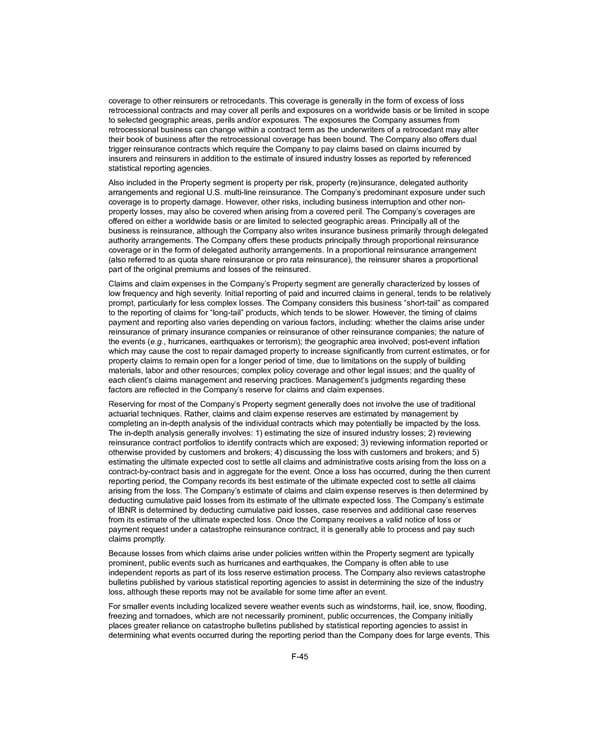coverage to other reinsurers or retrocedants. This coverage is generally in the form of excess of loss retrocessional contracts and may cover all perils and exposures on a worldwide basis or be limited in scope to selected geographic areas, perils and/or exposures. The exposures the Company assumes from retrocessional business can change within a contract term as the underwriters of a retrocedant may alter their book of business after the retrocessional coverage has been bound. The Company also offers dual trigger reinsurance contracts which require the Company to pay claims based on claims incurred by insurers and reinsurers in addition to the estimate of insured industry losses as reported by referenced statistical reporting agencies. Also included in the Property segment is property per risk, property (re)insurance, delegated authority arrangements and regional U.S. multi-line reinsurance. The Company’s predominant exposure under such coverage is to property damage. However, other risks, including business interruption and other non- property losses, may also be covered when arising from a covered peril. The Company’s coverages are offered on either a worldwide basis or are limited to selected geographic areas. Principally all of the business is reinsurance, although the Company also writes insurance business primarily through delegated authority arrangements. The Company offers these products principally through proportional reinsurance coverage or in the form of delegated authority arrangements. In a proportional reinsurance arrangement (also referred to as quota share reinsurance or pro rata reinsurance), the reinsurer shares a proportional part of the original premiums and losses of the reinsured. Claims and claim expenses in the Company’s Property segment are generally characterized by losses of low frequency and high severity. Initial reporting of paid and incurred claims in general, tends to be relatively prompt, particularly for less complex losses. The Company considers this business “short-tail” as compared to the reporting of claims for “long-tail” products, which tends to be slower. However, the timing of claims payment and reporting also varies depending on various factors, including: whether the claims arise under reinsurance of primary insurance companies or reinsurance of other reinsurance companies; the nature of the events ( e.g. , hurricanes, earthquakes or terrorism); the geographic area involved; post-event inflation which may cause the cost to repair damaged property to increase significantly from current estimates, or for property claims to remain open for a longer period of time, due to limitations on the supply of building materials, labor and other resources; complex policy coverage and other legal issues; and the quality of each client’s claims management and reserving practices. Management’s judgments regarding these factors are reflected in the Company’s reserve for claims and claim expenses. Reserving for most of the Company’s Property segment generally does not involve the use of traditional actuarial techniques. Rather, claims and claim expense reserves are estimated by management by completing an in-depth analysis of the individual contracts which may potentially be impacted by the loss. The in-depth analysis generally involves: 1) estimating the size of insured industry losses; 2) reviewing reinsurance contract portfolios to identify contracts which are exposed; 3) reviewing information reported or otherwise provided by customers and brokers; 4) discussing the loss with customers and brokers; and 5) estimating the ultimate expected cost to settle all claims and administrative costs arising from the loss on a contract-by-contract basis and in aggregate for the event. Once a loss has occurred, during the then current reporting period, the Company records its best estimate of the ultimate expected cost to settle all claims arising from the loss. The Company’s estimate of claims and claim expense reserves is then determined by deducting cumulative paid losses from its estimate of the ultimate expected loss. The Company’s estimate of IBNR is determined by deducting cumulative paid losses, case reserves and additional case reserves from its estimate of the ultimate expected loss. Once the Company receives a valid notice of loss or payment request under a catastrophe reinsurance contract, it is generally able to process and pay such claims promptly. Because losses from which claims arise under policies written within the Property segment are typically prominent, public events such as hurricanes and earthquakes, the Company is often able to use independent reports as part of its loss reserve estimation process. The Company also reviews catastrophe bulletins published by various statistical reporting agencies to assist in determining the size of the industry loss, although these reports may not be available for some time after an event. For smaller events including localized severe weather events such as windstorms, hail, ice, snow, flooding, freezing and tornadoes, which are not necessarily prominent, public occurrences, the Company initially places greater reliance on catastrophe bulletins published by statistical reporting agencies to assist in determining what events occurred during the reporting period than the Company does for large events. This F-45
 2021 Annual Report Page 187 Page 189
2021 Annual Report Page 187 Page 189